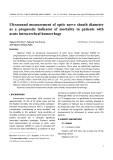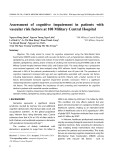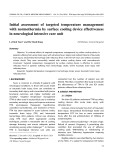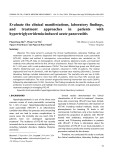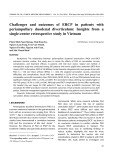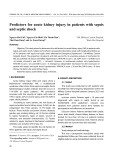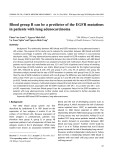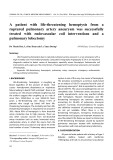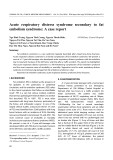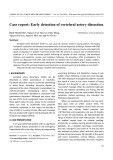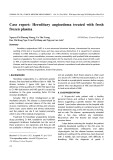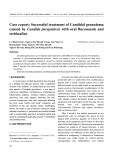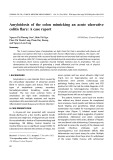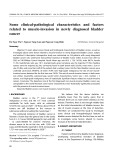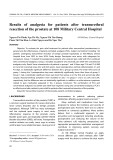Physicochemical characterization of carboxymethyl lipid A derivatives in relation to biological activity Ulrich Seydel1, Andra B. Schromm1, Lore Brade1, Sabine Gronow1, Jo¨ rg Andra¨ 1, Mareike Mu¨ ller1, Michel H. J. Koch2, Koichi Fukase3, Mikayo Kataoka3, Masaya Hashimoto3, Shoichi Kusumoto3 and Klaus Brandenburg1
1 Forschungszentrum Borstel, Leibniz-Zentrum fu¨ r Medizin und Biowissenschaften, Borstel, Germany 2 European Molecular Biology Laboratory, c ⁄ o DESY, Hamburg, Germany 3 Osaka University, Department of Chemistry, Osaka, Japan
; inflammation;
2
Keywords endotoxic shock lipopolysaccharide; signal transduction
Correspondence U. Seydel, Forschungszentrum Borstel, Division of Biophysics Parkallee 10, D-23845 Borstel, Germany Fax: +49 4537 188632 Tel: +49 4537 188232 E-mail: useydel@fz-borstel.de
(Received 6 September 2004, revised 3 November 2004, accepted 5 November 2004)
doi:10.1111/j.1742-4658.2004.04471.x
1
Lipopolysaccharide (LPS) from the outer membrane of Gram-negative bac- teria belongs to the most potent activators of the mammalian immune sys- tem. Its lipid moiety, lipid A, the ‘endotoxic principle’ of LPS, carries two negatively charged phosphate groups and six acyl chain residues in a defined asymmetric distribution (corresponding to synthetic compound 506). Tetraacyl lipid A (precursor IVa or synthetic 406), which lacks the two hydroxylated acyl chains, is agonistically completely inactive, but is a strong antagonist to bioactive LPS when administered to the cells before LPS addition. The two negative charges of lipid A, represented by the two phosphate groups, are essential for agonistic as well as for antagonistic activity and no highly active lipid A are known with negative charges other than phosphate groups. We hypothesized that the phosphate groups could be substituted by other negatively charged groups without changing the endotoxic properties of lipid A. To test this hypothesis, we synthesized lipid A (CM-506 and Bis- carboxymethyl (CM) derivatives of hexaacyl CM-506) and of lipid A (Bis-CM-406) and correlated their tetraacyl physicochemical with their endotoxic properties. We found that, similarly to compounds 506 and 406, also for their carboxymethyl derivatives a par- ticular molecular (‘endotoxic’) conformation and with that, a particular aggregate structure is a prerequisite for high cytokine-inducing capacity and antagonistic activity, respectively. In other parameters such as acyl chain melting behaviour, antibody binding, activity in the Limulus lysate assay, and partially the binding of 3-deoxy-d-manno-oct-2-ulosonic acid transferase , strong deviations from the properties of the phosphorylated compounds were observed. These data allow a better understanding of endotoxic activity and its structural prerequisites.
(LPS,
Abbreviations ATR, attenuated total reflectance; CM, carboxymethyl; EU, endotoxin unit; FRET, fluorescence resonance energy transfer; GlcN, D-glucosamine; Kdo, 3-deoxy-d-manno-oct-2-ulosonic acid; LAL, Limulus amebocyte lysate; LBP, lipopolysaccharide-binding protein; LPS, lipopolysaccharide; M-CSF, macrophage colony-stimulating factor; MNC, mononuclear cells; NBD, 7-Nitrobenz-2-oxa-1,3-diazol-4-yl; PE, phosphatidylethanolamine; Rh, rhodamine; TLR, Toll-like receptor; TNF, tumor necrosis factor.
FEBS Journal 272 (2005) 327–340 ª 2004 FEBS
327
Lipopolysaccharide endotoxin), as a major amphiphilic component of the outer leaflet of the outer membrane of Gram-negative bacteria, exerts in an isolated form a variety of biological activities in mam- mals [1]. Chemically, LPS consists of a hydrophilic heteropolysaccharide, which is covalently linked to a
U. Seydel et al.
Characterization of carboxymethyl lipid A
OH
O
R4
O
O
O
HO
O
NH
O
NH
R1
.
.
O
O O
O R3
O R2
.
.
OH
OH
14
14
14
14
2
2
12
14
14
2
12
Te traacyl lipid A (406) Bis-CM-406 Hexaacyl lipid A (506) CM - 506 Bis-CM-506
R 2 OH OH C -OH C -OH C -OH
R1 P CH COOH P CH COOH CH COOH
R3 OH OH C -OH C -OH C -OH
R4 P CH COOH P P CH COOH
2
14
2
12
Fig. 1. Chemical structures of synthetic tetraacyl and hexaacyl lipid A analogs. P, phosphate groups; R1–R4, side groups as indicated.
26
such as Toll-like [8,9], which finally transport the compounds to integral membrane proteins receptor 4 (TLR4) [10] or the K+-channel MaxiK [11].
termed lipid A, which hydrophobic lipid moiety, anchors the molecule to the outer leaflet of the outer membrane. Because free lipid A has been shown to be responsible for the biological activity of LPS in most in vitro and in vivo test systems, it has been termed the ‘endotoxic principle’ of endotoxin [2]. The specific requirements for endotoxin to be biologically active are still only partly defined. It has been shown, how- ever, that for the full expression of biological activity, lipid A must possess a particular chemical composition and primary structure like that found in enterobacteri- al strains. Thus, for example, lipid A from the biolo- gically most potent LPS of the deep rough mutant strain Escherichia coli F515 consists of a b-1,6-linked d-glucosamine (GlcN) disaccharide carrying two negat- ively charged phosphate groups in the 1- and 4¢-posi- in a defined tions and six saturated fatty acids asymmetric distribution – four at the nonreducing and two at the reducing GlcN. Variation of this composi- tion such as a reduction of the number of charges or the number of acyl chains, a change in their distribu- tion, or degree of saturation, results in a dramatic reduction of biological activity [3,4]. These observa- tions could be interpreted to indicate that a variation of the primary structure of endotoxin molecules influ- ences their physicochemical behaviour, and that this physicochemical behaviour is correlated to the biologi- cal activity.
3
Results
It has been reported that a prerequisite for endo- toxic activity is a sufficiently high number of negative charges, i.e., essentially the phosphate groups in the lipid A region [12]. However, no systematic study on the role of the kind of charges has been performed. Thus, in the present study the phosphate groups in the synthetic tetraacyl and hexaacyl compounds (406 and respectively) were replaced by carboxymethyl 506, corresponding compounds (CM) groups, and the (Bis-CM-406, CM-506, and Bis-CM-506; chemical structures shown in Fig. 1) were characterized physico- chemically and biologically. We have found that important characteristics such as the aggregate struc- tures and the cytokine-inducing properties remain essentially unchanged or are modified only slightly. Partially clear modifications are observed in the recog- nition by serum and cell-surface binding proteins. However, other important features like Limulus activ- ity and antibody binding change upon replacement of the phosphate groups by the carboxymethyl groups. These findings allow a more general understanding of endotoxin action.
Phase transition behaviour and intramolecular conformation Lipid A is an amphiphilic molecule and therefore tends to form multimeric aggregates above a critical concentration, which depends on its hydrophobicity. The structures of lipid A aggregates were found to be either nonlamellar inverted (cubic, Q or hexagonal, HII) or lamellar (L) depending on the primary chemical structure and the molecular shape of the composing molecules [5]. We have previously shown that a pecu- liar molecular shape of the lipid A portion of endotoxin is a prerequisite for the expression of endotoxic activ- ity. Thus, hexaacyl lipid A (or synthetic compound 506), which adopts a nonlamellar cubic aggregate struc- ture, with a conical molecular shape, is biologically highly active [6]. Pentaacyl lipid A and tetraacyl lipid A form lamellar structures, (synthetic compound 406) which can be related to a cylindrical molecular shape, and are agonistically inactive, but may be antagonistic, i.e., block the action of agonistic LPS [6]. Furthermore, we have reported that nonlipid A amphiphiles with cor- responding conical shape and two phosphates may also induce cytokines. This observation led us to propose a ‘generalized endotoxic principle’ [7].
FEBS Journal 272 (2005) 327–340 ª 2004 FEBS
328
The b «a gel to liquid crystalline acyl chain melting transition, the conformation and molecular orientation to the of particular molecular groups with respect For all these endotoxically active compounds, cell activation takes place after binding to proteins such as lipopolysaccharide-binding protein (LBP) and CD14
U. Seydel et al.
Characterization of carboxymethyl lipid A
2854
2853
) 1 –
406 Bis-CM-406 506 CM-506 Bis-CM-506
2852
2851
m c ( r e b m u n e v a W
2850
2849
0
10
20
30
40
50
60
70
Temperature (C°)
Fig. 2. Gel to liquid crystalline phase behav- ior of the hydrocarbon chains of the various synthetic lipid A analogs. The peak position of the symmetric stretching vibration of the methylene groups vs(CH2) is plotted vs. temperature. In the gel phase it is located around 2850 cm)1, in the liquid crystalline phase around 2852.5 to 2853.0 cm)1.
membrane plane of the synthetic compounds were investigated as potentially important determinants of bioactivity [13].
for from 2850 cm)1
Infrared spectra in the range 1800–1500 cm)1 for com- Fig. 3. pounds 406 and Bis-CM-406, exhibiting the ester carbonyl band around 1730 cm)1, the amide I band (predominantly C¼O stretch- ing) in the range 1620–1660 cm)1, and amide II band (predomin- antly N–H bending) around 1550 cm)1. The band around 1602 cm)1 for compound Bis-CM-406 corresponds to the antisymmetric stretching vibration of the the negatively charged carboxylate group vas(COO–).
In Fig. 2, the temperature dependence of the peak position of the symmetric stretching vibrational band vs(CH2) for the different compounds reveals a con- siderable influence of the phosphate substitution in the case of the tetraacyl compounds. The phase transition temperature Tc of compound 406 around 25 (cid:1)C is shifted for compound Bis-CM-406 to 46 (cid:1)C, in the gel concomitantly the wavenumber values phase decrease from around 2851 cm)1 to lower than 2850 cm)1, indicating a higher state of order (lower fluidity). In contrast, the Tc values of the hexaacyl compounds are very similar and lie slightly above 50 (cid:1)C. The wavenumber values in the gel phase compound 506 to decrease 2849.5 for CM-506 and to 2849.0 cm)1 for Bis-CM- 506. The comparison of the different compounds at the biologically relevant temperature 37 (cid:1)C (vertical line) shows the same sequence.
that, higher order. Furthermore, the shoulder at 1600– 1607 cm)1 for Bis-CM-406 should correspond to the antisymmetric stretching of the negatively charged carboxylate group [vas(COO–)], showing the molecule in the charged state at neutral pH.
FEBS Journal 272 (2005) 327–340 ª 2004 FEBS
329
Infrared spectra in the wavenumber range 1800– 1500 cm)1 of the amide and ester vibrational bands are compared exemplarily for 406 and Bis-CM-406 (Fig. 3). The peak positions of the ester band contours are around 1740–1742 cm)1 and 1728–1731 cm)1, respectively (obtained from the second derivative), and thus similar for both. The bandwidth, however, for Bis-CM-406 is smaller, indicating less mobility of the ester groups than those of phosphorylated 406. Importantly, also the amide I band, predominantly resulting from C¼O stretching of the amide group, is located at lower wavenumbers and is sharper, indica- ting stronger water and ⁄ or cation binding and, with To determine the orientation of the diglucosamine group with respect to the membrane plane, infrared dichroic measurements on an attennuated total reflectance (ATR) plate were performed with hydra- ted lipid multilayers. The dichroic ratios, R, were
U. Seydel et al.
Characterization of carboxymethyl lipid A
Table 1. Dichroic ratio R, order parameter S, and inclination angle h between diglucosamine ring plane and membrane plane for the synthetic lipid A analogs. The R values were evaluated from the ratio of the band intensities of the 90(cid:1) and 0(cid:1) polarized infrared spectra of the diglucosamine ring vibrations at 1045 and 1170 cm)1. The error of h results from calculating the Gaussian error propagation by using the functional relation between R, S and h [14].
Parameter
inverted hexagonal HII structure, because 4.61 nm ¼ 2.67 nmÆv3 and 4.61 nm ¼ 2.31 nmÆv4. This phase is already observable at 60 (cid:1)C (data not shown). Respect- ive data for the phosphorylated compounds show only (multi)lamellar structures for 406 [6], and a higher ten- dency of compound 506 towards a cubic structure (data not shown).
Dichroic ratio R
Order parameter S
Compound
Inclination angle h ((cid:1))
1.33
406
20.4 ± 14.0 16.5 ± 18.2 7.1 ± 28.3
Bis-CM-406
1.60
Incorporation into phospholipid cell membranes
15.0 ± 3.8 9.0 ± 7.1 4.9 ± 12.0
As a prerequisite for agonistic as well as antagonistic activity, the intercalation of endotoxins into target cell membranes corresponding to the composition of the macrophage membrane mediated by the LBP has been described [15].
506 CM-506 Bis-CM-506
0.98 1.05 1.01
0.55 0.46 0.33 0.69 0.56 0.49 0.96 0.88 0.93
46.8 ± 1.3 47.6 ± 1.6 47.5 ± 1.2
The results for the synthetic compounds are presen- ted in Fig. 5, showing most pronounced intercalation of the tetraacylated compound 406, and significantly lower efficiencies for the other compounds.
Binding of monoclonal antibodies
recognize variations
corresponding to small tetraacyl,
measured for ring vibrational the diglucosamine bands at 1170 and 1045 cm)1, allowing calculation of the inclination angle of the diglucosamine ring plane with respect to the membrane plane [14]. In Table 1, the data are summarized showing high R values for the inclination angles (5–20(cid:1)), and much smaller R values for the hexaacyl compounds corresponding to high inclina- tion angles (47–48(cid:1)).
Supramolecular aggregate structures
using
The reactivities of several lipid A monoclonal antibod- ies with compounds CM-506 and Bis-CM-506 were compared to compound 506 using an ELISA. Selected in the hydrophilic antibodies backbone as follows (Fig. 6A): the monoclonal anti- bodies A6 and 8A1 recognize the bisphosphorylated backbone, mAb S1 binds to the 4¢-monophosphory- lated backbone and mAb A43 reacts with phosphoryl- ated as well as with phosphate-free compounds [16]. As one example, the data of the phosphate-dependent mAb A6 and of the phosphate-independent mAb A43 are shown in Fig. 6B, displaying antibody binding curves determined by checkerboard titration. The results show that both mAb’s bind with high affinity to compound 506. mAb A43 binds with similarly high affinities to compounds 506, CM-506, and Bis-CM- 506, whereas mAb A6 binds with high affinity only to compound 506. Binding to compound CM-506 was observed only at much higher antibody concentrations and no binding was observed to Bis-CM-506. mAb 8A1 gave similar results as mAb A6 (data not shown). mAb S1, which recognizes the 4¢-monophosphorylated backbone, reacted not only with compound 506 but also with compound CM-506 although with somewhat lower affinity. No binding of mAb S1 to compound Bis-CM-506 was observed.
Limulus amebocyte lysate (LAL)
FEBS Journal 272 (2005) 327–340 ª 2004 FEBS
330
The aggregate structure has been described to be an essential determinant for the ability of endotoxins to induce cytokines in immune cells [5]. We have applied synchrotron diffraction small-angle X-ray radiation to elucidate the aggregate structure of Bis- CM-406 and Bis-CM-506 (Fig. 4). For the tetraacyl compound (Fig. 4A), in the temperature range 20– 80 (cid:1)C only one sharp diffraction peak at 4.72 nm is observed, which can be assigned to the periodicity of a multilamellar stack. The diffraction pattern of the hexaacyl compound (Fig. 4B) is more complex. At 40 (cid:1)C, the main diffraction peak at 4.53 nm may be assumed to result from a multilamellar aggregate. The further reflections at 2.46, 1.94, and 1.16 nm, however, belong to a different type of aggregate structure. Thus, a superposition of a lamellar and a cubic phase is sug- gested, because the relations 2.46 nmÆv5 ¼ 5.50 nm and 1.94 nmÆv8 ¼ 5.50 nm hold. At 80 (cid:1)C, the three observable reflections are clearly indicative of an The ability of the synthetic compounds to activate the clotting cascade of the horseshoe crab Limulus
U. Seydel et al.
Characterization of carboxymethyl lipid A
A
4.72 nm
Bis-CM-406 20 °C 40 80
I g o
l
B
4.61 nm
4.53 nm
Bis-CM-506 40 °C 80
2.67 nm
2.32 nm
I g o
l
1.16 nm
1.94 nm
2.46 nm
0.2
0.4
0.6
0.8
s (nm -1)
Fig. 4. Synchrotron radiation small-angle X-ray diffraction patterns for compounds Bis-CM-406 (A) and Bis-CM-506 (B) at high water content (90%) and different temperatures.
2.5
406
2.0
Bis-CM-406
1.5
A I / D I
506 Bis-CM-506
CM-506
PL liposomes
1.0
Buffer
+ LBP
0.5
50
100
150
200
250
300
Time (s)
Fig. 5. LBP-mediated intercalation of the synthetic lipid A analogs into phospholipid liposomes corresponding to the composition of the macrophage membrane, derived from the increase of the ratio of the donor fluor- escence intensity, ID, to that of the accep- tor, IA. At 50 s, the lipid A analogs were added to the liposomes, and at 100 s LBP was added.
the influence of
the LAL assay [17,18],
polyphemus gave highest values for compound 406, followed by 506 and CM-506 (Table 2). Considering that the diglucosamine 4¢-phosphate backbone is the recognition structure of it seems surprising that compounds Bis-CM406 and Bis- also showed high reactivity down to CM-506 10 ngÆmL)1. lower. The activity of
Cytokine-inducing capacity in macrophages shown). For both compounds
FEBS Journal 272 (2005) 327–340 ª 2004 FEBS
331
As a characteristic endotoxic reaction, the induction tumor necrosis factor a (TNFa) production in of human macrophages by the synthetic compounds was the determined. Concomitantly, specific MaxiK channel blocker paxilline on TNFa production was monitored. Data are shown for com- pounds 506 and Bis-CM-506 (Fig. 7) revealing cyto- kine-inducing capacity down to 1 ngÆmL)1 for the former, whereas the activity of the latter is one order of magnitude compound CM-506 is nearly the same as for compound 506 inhibi- (data not tion due to the addition of paxilline can clearly lipid be observed, in particular lower the at
U. Seydel et al.
Characterization of carboxymethyl lipid A
A
A43
S1
A6, 8A1
GlcN II
P
P
GlcN I
N
O
O
N
OH
OH
14
14
14
12
14
14
B
Fig. 6. (A) Schematic representation of spe- cificities of various monoclonal antibodies against the lipid A backbone. The recogni- tion structures of the mAbs A43, S1, and A6 ⁄ 8A1 are GlcNII, diglucosamine-4¢-phos- phate, and the entire backbone, respect- ively. (B) Binding curves of monoclonal antibodies A6 (left column) and A43 (right column) to compounds 506 (top), CM-506 (middle), and Bis-CM-506 (bottom). ELISA plates were coated with 400 (d), 200 (m), 100 (j), 50 (r), 25 (s), 12.5 (n), 6.3 (h) and 3.1 (e) ng of compound per mL. Antibody concentrations are indicated. Values are the mean of quadruplicates with confidence values not exceeding 10%.
FEBS Journal 272 (2005) 327–340 ª 2004 FEBS
332
concentrations, which is, however, significantly higher for the CM- as compared to the phosphate-contaning compound. This observation allows one to conclude that channel blocking leads to inhibition of signal transduction. Again, results are found for similar CM-506.
U. Seydel et al.
Characterization of carboxymethyl lipid A
three independent sets of measurements.
Table 2. Endotoxic activity in endotoxin unitsÆmL)1 (EUÆmL)1) in the chromogenic Limulus amebocyte lysate test for the synthetic lipid A analogs at various concentrations. The data are representa- tive of In the test, 14 EUÆmL)1 corresponds to 1 ngÆmL)1 of LPS from Escherichia coli O55:B5.
Concentration
Lipid
1 lgÆmL)1
100 ngÆmL)1
10 ngÆmL)1
1 ngÆmL)1
100 pgÆmL)1
> 125
> 125
> 125 > 125
61.5
45.84 1.76
Antagonistic activity
> 125 > 125
406 Bis-CM-406 506 CM-506 Bis-CM-506
> 125
82.8
15.6 11.8 4.5
11.3 76.1 23.6 12.5
1.96 0.89 3.16 2.20 1.43
Compound 406 is a well known effective antagonistic agent against agonistically active LPS and lipid A [19]. The antagonistic action of compound Bis-CM-406 was compared to that of 406 by the addition of these com- pounds to mononuclear cells under serum-free condi- tions 15 min prior to the addition of deep rough mutant LPS in defined [antagonist] ⁄ [LPS] molar ratios. Figure 8 shows a strong cytokine-inhibiting activity of compound 406, which is also expressed, but to signifi- cantly lesser extent by compound Bis-CM-406.
HEK cell system
Similar to compound 506, compound Bis-CM-506 acti- vates HEK293 cells via TLR4 ⁄ MD2, but not via TLR2 (Fig. 9). Thus, the change in the nature of charges does not cause changes in the affinity to recep- tors decisive for cell activation.
Reactivity with Kdo transferases
Fig. 8. Antagonistic activity of compounds 406 and Bis-CM-406. Human mononuclear cells were incubated under serum-free condi- tions with the antagonistic compound, and after 15 min LPS from Salmonella minnesota R595 was added at the given molar ratios. The data result from one representative experiment. The mean and standard deviation are based on the data from the determination of TNFa in duplicate at two different dilutions.
Induction of TNFa production in human macrophages by Fig. 7. compounds 506 (A) and Bis-CM-506 (B) in the absence (left-hand bars) and presence (right-hand bars) of the K+-channel blocker paxil- line at different lipid concentrations. The concentration of paxilline was 20 lM.The data result from one representative experiment. The mean and standard deviation are based on the data from the determination of TNFa in duplicate at two different dilutions. A the experiments yielded the same dependences repetition of except for the absolute amount of TNFa production which may vary significantly between different donors.
FEBS Journal 272 (2005) 327–340 ª 2004 FEBS
333
To assess the lipid A analogs CM-506 and Bis-CM-506 in comparison to compound 506 as acceptors for 3-de- oxy-d-manno-oct-2-ulosonic acid (Kdo) transferases, they were submitted to in vitro enzyme assays, and the reaction products were detected with mAb A20, react- ing with a terminal Kdo residue (Fig. 10). Kdo trans- ferases from Haemophilus influenzae (monofunctional; [21], lane A) (bifunctional, [20], E. coli lane B)
U. Seydel et al.
Characterization of carboxymethyl lipid A
2000
Control huTLR4/MD2
TLR2/MD2
1500
) l
/
1000
505 (1-phosphate) showed that both phosphate resi- dues were necessary for binding of Kdo transferases from B. cepacia and C. psittaci, whereas those from E. coli and H. influenzae were reactive with each of the monophosphoryl analogs (data not shown).
500
Discussion
m g p ( n o i t a r t n e c n o c
8 - L
I
0
no
IL-1
Compound 506
Compound Bis-CM-506
Stimuli
stimulated with
compounds
Fig. 9. Activation of HEK293 cells by compounds 506 and Bis-CM- 506 in dependence on TLR-expression. HEK293 cell were transi- ently transfected with a control plasmid (pcDNA3), cotransfected with expression plasmids for human TLR4 and human MD2 or for human TLR2 as described in Materials and methods. After 24 h, 506, Bis-CM-506 cells were (1 lgÆmL)1), or recombinant interleukin-1 (5 ngÆmL)1) for 24 h. Cell activation was determined by measuring the IL-8 concentration in an ELISA test. Transfections were performed in triplicate, and data given are mean and standard deviation of one experiment represen- tative of three.
6
E
C
B
A
D
506
CM-506
Bis-CM-506
406
Fig. 10. In vitro assays of different Kdo transferases using com- pounds 506, CM-506, Bis-CM-506 and 406 as lipid acceptors. Reac- tion products of Kdo transferases from H. influenzae (A), E. coli (B), B. cepacia (C), C. psittaci (D) or controls without enzyme added (E) were detected with mAb A20, recognizing a terminal Kdo residue.
4
5 The CM derivatives of lipid A exhibit in many aspects comparable behavior to that of the phosphate-contain- ing compounds. The substitution of the 1-phosphate by CM has already been shown not to alter the basic cyto- kine-inducing capacity of compound 506 [14], and this is similarly true for the further substitution with the 4¢-CM group (Fig. 7B). There is, however, a significant decrease of the activity in particular for the lower con- centrations 10 and 1 ngÆmL)1 (Fig. 7), which could be confirmed in three experiments. The independent observed aggregate structures may provide an explan- ation for this difference (Fig. 4B and U Seydel, AB Schromm, L Brade, S Gronow, J Andra¨ , M Mu¨ ller, MHJ Koch, K Fukase, M Kataoka, M Hashimoto, S Kusumoto & K Brandenburg, unpublished data) . Compound Bis-CM-506 adopts a mixed multilamellar ⁄ zcubic aggregate structure at 40 (cid:1)C. According to previ- ous work, one main structural prerequisite for endo- toxic activity is the existence of a pure cubic or a mixed unilamellar ⁄ cubic aggregate structure of the lipid A part of LPS [24], whereas multilamellar structures have been shown to reflect inactive lipid A. Thus, the signifi- cant amount of a multilamellar portion within the aggregate may be responsible for the reduction of activ- ity as compared to natural lipid A or synthetic com- for pound 506. Regarding the other prerequisites endotoxin activity, no significant difference between the two compounds can be found. For example, the incli- nation angle of the diglucosamine plane with respect to the membrane plane is very similar (Table 1). Thus, the interpretation is confirmed that the driving force for an optimal packing of the acyl chains is their linkage and distribution to the two glucosamines, causing the observed high inclination independent of the type of charges [14]. Also, all compounds show an LBP- induced intercalation into phospholipid liposomes (Fig. 5), for which the presence of negative charges is a prerequisite. The presence of the infrared band around 1605 cm)1 (Fig. 3) clearly indicates that the carboxylate group is in the ionized state.
FEBS Journal 272 (2005) 327–340 ª 2004 FEBS
334
Analogously to the agonistically active hexaacyl compounds is the antagonistic activity of the tetraacyl compounds: Bis-CM-406 is also antagonistic, although to a significantly lower degree than 406 (Fig. 8). Cor- responding to the data of the antagonistic activity Burkholderia cepacia (bifunctional, lane C) [22], and Chlamydia psittaci (tetrafunctional, lane D) [23] were tested for their ability to use the artificial lipid A ana- logs as substrates. All Kdo transferases gave a product when compound 506 served as acceptor, and the same were observed when compound CM-506 was offered as acceptor (data not shown). However, compound Bis-CM-506 was transformed to a Kdo-containing product only when incubated with Kdo transferases from H. influenzae or E. coli, but not with enzymes from B. cepacia or C. psittaci. The use of monophos- phoryl compound 504 (having the 4¢-phosphate) and
U. Seydel et al.
Characterization of carboxymethyl lipid A
structure
answer this question. The binding of mAb A43, which recognizes the nonreducing GlcN moiety in the back- bone of compound 506 is not influenced by the replacement of phosphate groups by CM residues. This is in agreement with the known specificity of mAb A43, which does not require the phosphate substitu- tion in either position. The binding of mAb A6 and 8A1 to compound CM-506 (for the latter, data not shown) is considerably reduced as compared to com- pound 506 (Fig. 6). This result is also not unexpected because previous data had already shown that binding of both mAbs to 4¢-monophosphorylated lipid A required 30-fold higher antigen concentrations than those needed with bisphosphorylated lipid A [16]. No binding of mAbs A6 and 8A1 was observed with Bis- CM-506 showing that the bisphosphorylated backbone is a prerequisite for high affinity binding.
found for compound 406 [6], a pure multilamellar aggregate is observed for Bis-CM-406 (Fig. 4A), and the inclination angle of the diglucosa- mine ring plane with respect to the membrane plane is small (Table 1). Furthermore, LBP mediates the inter- calation of compound 406 into phospholipid mem- branes more effectively than compound Bis-CM-406 (Fig. 5). This observation might be connected with the much higher fluidity of compound 406 as compared to compound Bis-CM-406: for these compounds the behavior of the carboxymethyl derivatives is strongly deviating from that of compounds substituted with phosphate groups (Fig. 2). The replacement of phos- phate by carboxymethyl leads to an overall decrease of the wavenumbers of vs(CH2) and concomitantly an increase in Tc (Fig. 2), i.e., a considerable ordering of the hydrophobic moiety takes place. This observation may be understood in the light of a dramatically increased water ⁄ cation binding of the interface as deduced from the red shift of the amide I band (Fig. 3), which is caused by the presence of the carb- oxymethyl groups.
In summary, the data confirm that lipid A antibod- ies, except mAb A43, recognize a distinct phosphoryla- tion pattern of the lipid A backbone and confirm that phosphates are part of the epitopes recognized, which cannot be replaced simply by other negatively charged groups. This may be understood by different negative charge densities within the phosphate and the carboxy- methyl groups.
7 These data are in accordance with the fact that the most potent antagonists described so far [25,26] have an extremely high fluidity. This holds for lipid A from Rhodobacter capsulatus and Rhodobacter sphaeroides as well as for lipid A from Chromobacterium violaceum ([5] and U Seydel, AB Schromm, L Brade, S Gronow, J Andra¨ , M Mu¨ ller, MHJ Koch, K Fukase, M Kata- oka, M Hashimoto, S Kusumoto & K Brandenburg, . unpublished data)
in human capacity cytokine-inducing cytokine the
involvement of the
Recently, it has been described that a blockade of the K+-channel, MaxiK, by the specific blocker paxil- line is connected to an inhibition of cytokine induc- tion in macrophages [11]. The test of the synthetic hexaacyl compounds showed that although Bis-CM- 506 is less effective than 506 in the cytokine assay, the action of the K+-channel (MaxiK) blocker paxil- line is reversed: our data indicate a higher efficiency in the case of the carboxylated compound; a complete induction is observed blockade of already at 100 ngÆmL)1 for Bis-CM-506 (Fig. 7). Together with the data of the activation of HEK cells the (Fig. 9), which indicate TLR4 ⁄ MD2 complex in cell activation, these data provide clear evidence that not a single molecular species but rather a complete receptor cluster [27] governs cell signalling.
recognizes patterns rather The results from the LAL test for the bioactivity (Table 2) are fundamentally different from those for cells, the because in the former the tetra- and hexaacyl lipid A CM-analogs exhibit similar activities except for minor modifications, in that the biscarboxymethylated com- pounds exhibit a lower activity than the phosphate- containing compounds. This may be understood by considering previous findings that the main epitope in the Limulus test is the GlcNII-4¢-phosphate region in the lipid A backbone [17,18]. A substitution of the 4¢-phosphate by another charge does not lead to a complete inhibition, which implies that the Limulus test than a particular charged group.
FEBS Journal 272 (2005) 327–340 ª 2004 FEBS
335
Interestingly, both lipid A analogs show different properties when used as acceptors for Kdo transfer- ases. Whereas the enzymes from H. influenzae and E. coli are not depending on either phosphate residue substituting the lipid A backbone and recognize both compounds CM-506 and Bis-CM-506 as acceptors, the respective enzymes from B. cepacia and C. psittaci are strongly depending on the phosphate group in position 4¢. Both Kdo transferases accept compound CM-506 but are not able to recognize compound Bis- CM-506 as a Kdo acceptor. Presently, the reason for The binding specificities of the monoclonal antibod- ies A6, 8A1, S1, and A43 are determined by the phos- phorylation pattern [16]. So far it has not be determined whether phosphate groups are specifically required or whether they may be replaced by other negatively charged groups. By synthesizing compounds CM-506 and Bis-CM-506, we are in the position to
U. Seydel et al.
Characterization of carboxymethyl lipid A
glycoside, which was further oxidized with NaClO2. The resulting carboxyl group was protected with benzyl group by using phenyldioazomethane. Deprotection of benzylidene gave the reducing-end GlcN moiety as a common glycosyl acceptor for the synthesis of Bis-CM-506 and Bis-CM-406.
9
Conclusions
For the synthesis of the nonreducing-end GlcN moiety, the common intermediate 1-O-allyl 4,6-O-benzylidene-3- O-((R)-3-benzyloxytetradecanoyl)-2-deoxy-2-(2,2,2-trichloro- ethoxy carbonylamino)-a-d-glucopyranoside was treated under the conditions of regioselective reduction of benzylid- and Et3SiH) to give the 6-O-benzyl-4-OH ene (BF3ÆOEt2 GlcN derivative. The benzyloxy carbonyl group was then introduced to the 4-O-position using Ag2O and ICH2COO- Bn. The 1-O-allyl group was then cleaved and transformed to 1-O-trichloroacetimidate, which was used as a glycosyl donor for the synthesis of Bis-CM-406. Glycosylation of the above glycosyl acceptor with the glycosyl donor gave the desired a(1-6) disaccharide. The 2¢-N-Troc group was cleaved, and the resulting amino group was acylated with (R)-3-benzyloxytetradecanoic acid to give the protected Bis- CM-406. The final catalytic hydrogenation gave the desired Bis-CM-406 (m ⁄ z ¼ 1360.0 [(M-H)–]).
this distinctive behavior of Kdo transferases cannot be explained completely, in particular with respect to the similarity of the molecular conformations of compounds 506 and Bis-CMz-506 (Table 1). How- ever, together with the data of the monophosphoryl lipid A compounds a necessary prerequisite for the binding of Kdo transferases is the existence of a charge at position 4¢. That two of the transferases bind to both compounds 506 as well as Bis-CM-506 and the other two do not, may have to do with the acyl chain substitution of the acceptor, which again may play a decisive role for the molecular conforma- tion. It was shown that LPS from H. influenzae sim- ilar to that from E. coli is hexaacylated [21], whereas those from B. cepacia [23] and C. psittaci [28] are pentaacylated.
For the synthesis of Bis-CM-506, the benzyl group of the benzyloxytetradecanoyl moiety in the above synthetic intermediate 1-O-allyl 6-O-benzyl-4-O-benzyloxycarbonyl- methyl-3-O-((R)-3-benzyloxytetradecanoyl)-2-deoxy-2-(2,2,2- trichloroethoxycarbonylamino)-a-d-glucopyra-noside was selectively cleaved using 2,3-dichloro-5,6-dicyanobenzoqui- none. The resulting hydroxy group of the fatty acid moi- ety was then acylated with tetradecanoic acid. After deprotection of the 1-O-allyl group and formation of 1-O- trichloroacetoimidate, glycosylation of the acceptor with 1-O-trichloroacetoimidate gave the disaccharide, which was then transformed to Bis-CM-506 in a similar manner (m ⁄ z ¼ 1753.1 [(M-H)–]).
The chemical structures of the synthesized compounds
are plotted in Fig. 1.
Materials and methods
The mere presence of two negative charges but not their kind within the lipid A backbone is essential for the bioactivity of endotoxins, for the agonistic as well as the antagonistic activities. These findings confirm and extend our ‘conformational concept’ of endotoxicity, presuming for agonists a conical shape of the lipid A moiety with a high inclination angle of the acyl chains with respect to the membrane surface and for antago- nists a cylindrical shape with a low inclination angle. For other effects, however, for which particular binding epitopes are necessary, exchange of charges may largely change the bioactivities. This is valid for the recognition by monoclonal antibodies, the binding of Kdo trans- ferases, and the reactivity in the Limulus test.
compounds
previously. Monophosphoryl
10
8
Lipopolysaccharide from the deep rough mutant Escheri- chia coli strain WBB01 (kindly provided by W Brabetz, was extracted by the phe- Biomet, Dresden, Germany) from bacteria nol ⁄ chloroform ⁄ petrol ether method [33] grown at 37 (cid:1)C, purified, and lyophilized. Paxilline was purchased from Sigma (Deisenhofen, Germany). LBP was a kind gift of RL Dedrick (XOMA Co., Berkeley, CA, USA). LBP was stored at ) 70 (cid:1)C as a 1 mgÆmL)1 stock solution in 10 mm Hepes, pH 7.5, 150 mm NaCl, 0.002% (v ⁄ v) Tween 80, 0.1% F68.
The lipids 3-sn-phosphatidylserine, egg 3-sn-phosphatidyl- choline, sphingomyelin from bovine brain, and 3-sn-phos- phatidylethanolamine from E. coli were from Avanti Polar Lipids (Alabaster, AL, USA).
The synthesis of hexaacyl lipid A compounds 506 [29,30], CM-506 [30], and tetraacyl lipid A 406 [31,32] has been pub- lished 504 (4¢-phosphate) and 505 (1-phosphate), used in some cases, were synthesized as described [29]. The synthesis of Bis-CM- 506 and Bis-CM-406 will be reported elsewhere (K Fukase, M Kataoka, M Hashimodo & S Kusumodo, unpublished Briefly, the 3-position of 1-O-allyl 4,6-O-benzylidene- data). 2-deoxy-2-(2,2,2-trichloroethoxycarbonylamino)-a-d-gluco- pyranoside was acylated with (R)-3-benzyloxytetradecanoic acid. The 2-N-Troc (Troc ¼ 2,2,2-trichloroethoxycarbonyl) group was cleaved, and the 2-amino group was then acylated with (R)-3-benzyloxytetradecanoic acid. The allyl group was then oxidized with OsO4, and the resulting diol was oxida- tively cleaved with Pb(OAc)4 to give 1-O-formylmethyl
FEBS Journal 272 (2005) 327–340 ª 2004 FEBS
336
Synthesis Lipids and reagents
U. Seydel et al.
Characterization of carboxymethyl lipid A
to a relationship between S, h and R as reported previously [14], was used.
Preparation of lipid aggregates
The synthetic lipid A analogs were dispersed in 20 mm Hepes (pH 7) buffer (lipid concentration 0.01–10 mm for the physical techniques and down to 100 pgÆmL)1 for the biological assays), vortexed, sonicated for 30 min, and sub- jected to several temperature cycles between 20 and 60 (cid:1)C. Finally, the lipid suspensions were incubated at 4 (cid:1)C for at least 12 h before use.
For preparation of liposomes corresponding to the com- position of the macrophage membrane, phosphatidyl- choline, phosphatidylserine, phosphatidylethanolamine and sphingomyelin in a molar ratio of 1 : 0.4 : 0.7 : 0.5 [12] were solubilized in chloroform, the solvent was evaporated under a stream of nitrogen, the lipids were resuspended in the appropriate volume of buffer, and treated as described above for the synthetic lipid A analogs.
X-ray diffraction experiments to define aggregate structures of the lipid A analogues were performed at the European Molecular Biology Laboratory (EMBL) outstation at the Hamburg synchrotron radiation facility HASYLAB using the double-focussing monochromator-mirror camera X33 [34]. X-ray diffraction patterns, obtained with exposure times of 2 min using a linear gas proportional detector with delay line readout [35], were evaluated according to previ- ously described procedures [24]. These allow one to assign the spacing ratios to defined three-dimensional aggregate structures, from which the conformation of the individual molecules can be deduced.
X-ray diffraction
FTIR spectroscopy
11
The infrared spectroscopic measurements were performed on an IFS-55 spectrometer (Bruker, Karlsruhe, Germany). For measurements of the gel to liquid crystalline phase transition, the lipid samples were placed in a CaF2 cuvette with a 12.5 lm Teflon spacer. Temperature scans were per- formed automatically between 10 and 70 (cid:1)C with a heating rate of 0.6 (cid:1)CÆmin)1. For measurement of hydrated sam- ples, the lipid samples were spread on an ATR Ge plate, and free water was evaporated. Every 3 (cid:1)C, 50 interfero- grams were accumulated, apodized, Fourier transformed, and converted to absorbance spectra.
Fluorescence resonance energy transfer (FRET) spectroscopy
Transport of the lipids into liposomes made from a phos- pholipid mixture corresponding to that of the macrophage membrane, mediated by LBP was determined by FRET spectroscopy using the dyes 7-Nitrobenz-2-oxa-1,3-diazol- 4-yl (NBD) phosphatidylethanolamine (NBD-PE) and rhod- amine (Rh)-PE. The FRET assay was performed as a probe dilution assay as described previously [12,15]. Briefly, phosp- holipid liposomes corresponding to the composition of the macrophage membrane were doubly labeled with NBD-PE and Rh-PE (Molecular Probes, Eugene, OR, USA). Interca- lation of unlabeled molecules into the doubly labeled lipo- somes leads to probe dilution, thus inducing a lower FRET efficiency: the emission intensity of the donor ID increases and that of the acceptor IA decreases (for clarity, only the quotient of the donor and acceptor emission intensity is shown here). To the doubly labeled liposomes first the lipids and then LBP were added, all at a final concentration of 10 lm.
Attenuated total reflectance (ATR) with polarized infrared light
Biological assays
lipids were prepared as hydrated oriented thin The multilayers as described previously [14] by spreading a 1 mm lipid suspension in 20 mm Hepes buffer (pH 7) on a ZnSe ATR crystal and evaporating the excess water by slow periodic movement under a nitrogen stream at room temperature. The lipid sample was placed in a closed cuvette, and the air above the sample was satur- ated with water vapour to maintain full hydration. Infra- red ATR polarized spectra at 0 and 90(cid:1) were recorded using a mercury-cadmium-telluride detector with a scan number of 1000 at a resolution of 2 cm)1. The measure- ments were performed at 28 (cid:1)C, the intrinsic instrument temperature.
14
13 Monocytes were isolated from peripheral blood taken from healthy donors by the Hypaque–Ficoll density gradient method. Experiments were undertaken with the understand- ing and written consent of each subject. To differentiate the monocytes from the macrophages, cells were cultivated in Teflon bags in the presence of 2 ngÆmL)1 macrophage colony-stimulating factor (M-CSF) in RPMI 1640 medium (endotoxin < 0.01 endotoxin units (EU)ÆmL)1 in Limulus test; Biochrom, Berlin, Germany) containing 2 mm l-gluta- mine, 100 UÆmL)1 penicillin, and 100 lgÆmL)1 streptomycin, and 4% heat-inactivated human serum type AB at 37 (cid:1)C and 6% CO2. On day 6 the cells were washed with NaCl ⁄ Pi,
Dichroic ratios, R, for particular vibrational bands from the diglucosamine backbone were evaluated at 1170 and 1045 cm)1. The angle h represents the angle between the diglucosamine backbone and the direction of the hydrocar- bon chains, and can be calculated from the measured R, if an approximate value of the order parameter, S, is known. As a first approximation, the S value calculated according
FEBS Journal 272 (2005) 327–340 ª 2004 FEBS
337
12 Stimulation of macrophages
U. Seydel et al.
Characterization of carboxymethyl lipid A
19
15
20
(LAL) at 37 (cid:1)C, using test kits of LAL Coamatic Chromo- LAL K (Chromogenix, Haemochrom Milano, Italy) ([37]). The standard endotoxin used in this test was from E. coli (O55:B5), and 10 EUÆmL)1 correspond to 1 ngÆmL)1. In this assay, saturation occurs at 125 EUÆmL)1, and the reso- lution limit is > 0.1 EUÆmL)1 (maximum value for ultra- pure water; Aqua B. Braun, Brann Melsungen, Germany)
.
16;17 (clone 16 from Intex AG 16;17
detached by trypsin ⁄ EDTA treatment and seeded at 1 · 105 per mL in complete medium in 96 well tissue culture plates (NUNC, Wiesbaden, Germany). After stimulation of the cells with the compounds 506 and Bis-CM-506 for 4 h, cell- free supernatant of duplicate samples were collected, pooled and stored at )20 (cid:1)C until determination of cytokine content. Immunological determination of TNFa in the cell super- natant was performed in a sandwich-ELISA as described before [36]. Monoclonal mouse anti-human TNFa IgG , Muttenz, Switzerland) was used to coat 96 well plates (Greiner, Solingen, Germany). Cell culture supernatants and the standard [recombinant human TNFa (rTNFa); Intex AG] were diluted with buffer. After exposure to appropriately diluted test samples and serial dilutions of standard rTNFa, the plates were exposed to peroxidase-conjugated sheep anti-TNFa IgG. Subsequently, the color reaction was started by addition of tetram- ethylbenzidine ⁄ H2O2 in alcoholic solution and stopped after 5–15 min by addition of 0.5 m sulfuric acid. In the color reaction, the substrate is cleaved enzymatically, and the product was measured photometrically on an ELISA reader at a wavelength of 450 nm and the values were related to the standard. TNFa was determined in duplicate at two dif- ferent dilutions and the values were averaged.
To study the influence of the K+-channel (MaxiK) on cytokine induction, the specific channel blocker paxilline was added at a concentration of 20 lm 10 min before sti- mulation by the synthetic compounds to the mononuclear cells, and incubated at 37 (cid:1)C.
HEK293 cells were transiently transfected using the follow- ing protocol. For transfection, 0.2 lg of the indicated plas- mids were diluted in 30 lL serum-free DMEM medium (Qiagen, Hilden, Germany) containing 2 mm l-glutamine, 100 UÆmL)1 penicillin, and 100 lgÆmL)1 streptomycin, added to the wells of a 96 well dish, and precipitated by addition of polyfect (1 lL in 20 lL serum-free DMEM) and incubation for 10 min at room temperature. Subsequently, HEK293 cells were directly seeded onto the precipitates at a density of 7.5 · 104 cells per well and incubated overnight at 37 (cid:1)C and 5% (v ⁄ v) CO2. The following day, cells were stimulated with the indicated amounts of the compounds 506 and Bis- CM-506, or recombinant human IL-1 (Peprotech, Rocky Hill, NJ, USA) for 24 h. Cell activation was determined by measuring IL-8 content in cell-free supernatants by using the human IL-8 Cytoset antibody pair for ELISA (Bioscource, Nivelles, Belgium), exactly according to the manufacturer’s protocol. Transient transfections were carried out in tripli- cate and data given are the mean and standard deviation.
Activation of HEK293 cells
18
21
Mononuclear cells (MNC) were isolated from peripheral blood taken from healthy donors by the Hypaque–Ficoll density gradient method. The cell number was equilibrated at 5 · 106 mL)1 RPMI 1640 containing 2 mm l-glutamine, 100 UÆmL)1 penicillin, and 100 lgÆmL)1 streptomycin. For stimulation, 200 lLÆwell)1 MNC were transferred into 96 well culture plates. The stimuli were serially diluted in RPMI 1640 and added to the cultures at 20 lLÆwell)1. To investigate the antagonistic effect the compounds 406 and Bis-CM-406 had on LPS-induced TNFa production, the antagonists were added to the cells 15 min prior to stimula- tion with deep rough mutant LPS. The cultures were incubated for 4 h at 37 (cid:1)C under 5% CO2. Cell-free supern- atants were collected after centrifugation of the culture plates for 10 min at 400 g and stored at )20 (cid:1)C until deter- mination of cytokine content (see above).
22
Antagonism Binding of monoclonal antibodies
For the analysis of the binding of antibodies to the back- bone of lipid A, monoclonal antibodies with different epi- tope specificities (Fig. 6A) were applied. The antibodies raised against lipid A were produced as described earlier [38]. The synthetic lipid A compounds were used in an ELISA as solid-phase antigen as described [20]. For this, polyvinyl plates (Falcon 3911, BD Biosciences, Franklin Lakes, NJ, USA) were coated with various amounts of lipid A dissolved in NaCl ⁄ Pi (10 mm pH 7.3, 0.9% NaCl, 50lL) at 4 (cid:1)C overnight. All following steps were performed at 37 (cid:1)C with gentle agitation, all washing steps were per- formed four times. Coated plates were washed in NaCl ⁄ Pi, treated for 1 h with blocking buffer (2.5% casein in NaCl ⁄ Pi) and then incubated for 1 h with mAb diluted in blocking buffer (50 lL). Plates were washed in NaCl ⁄ Pi and incubated for 1 h with peroxidase-conjugated goat anti-mouse IgG (heavy and light chain specific, (Dianova ; diluted 1 : 1000 in blocking buf- Hamburg, Germany) fer, 50 lL). After three washes in NaCl ⁄ Pi, the plates were washed in substrate buffer (0.1 m sodium citrate, pH 4.5). Substrate solution, which was prepared freshly, was composed of azinodi-3-ethylbenzthiazolinsulfonic acid (1 mg) dissolved in substrate buffer (1 mL) sonicated in an
Endotoxin activity of the lipid A analogs was determined by a quantitative kinetic assay based on the reactivity of Gram-negative endotoxin with Limulus amebocyte lysate
FEBS Journal 272 (2005) 327–340 ª 2004 FEBS
338
Determination of endotoxin activity by the chromogenic Limulus test
U. Seydel et al.
Characterization of carboxymethyl lipid A
Flad H-D, Schade UF, Di Padova F, Kusumoto S & Schumann RR (1996) Bacterial endotoxin: Chemical constitution, biological recognition, host response, and immunological detoxification. Curr Top Microbiol Immunol 216, 39–81.
23
ultrasound water bath for 3 min followed by the addition of H2O2 (25 lL of a 0.1% solution). After 30 min, the reac- tion was stopped by addition of 2% aqueous oxalic acid and the plates were read with a microplate reader (Dyna- MR5000, Dynatech Laboratories, Chantilly, VA, tech USA) at a wavelength of 405 nm.
All tests were set up in quadruplicate. Confidence values
of the means were less than 10%.
3 Za¨ hringer U, Lindner B & Rietschel ET (1994) Mole- cular structure of lipid A, the endotoxic center of bac- terial lipopolysaccharides. Adv Carbohydr Chem Biochem 50, 211–276.
4 Raetz CR (1990) Biochemistry of endotoxins. Annu Rev
Biochem 59, 129–170.
5 Brandenburg K, Mayer H, Koch MHJ, Weckesser J,
& Seydel U (1993) Influence of the supra-
24
Rietschel ET molecular structure of free lipid A on its biological activity. Eur J Biochem 218, 555–563.
6 Schromm AB, Brandenburg K, Loppnow H, Moran
AP, Koch MHJ, Rietschel ET & Seydel U (2000) Biolo- gical activities of lipopolysaccharides are determined by the shape of their lipid A portion. Eur J Biochem 267, 2008–2013.
7 Seydel U, Hawkins L, Schromm AB, Heine H, Scheel
Cell-free extracts containing Kdo transferase from E. coli, C. psittaci or H. influenzae were prepared from Corynebacte- rium glutamicum strains R163 ⁄ pJKB16, R163 ⁄ pJKB17 and R163 ⁄ pCB23, respectively, as described previously [39]. From B. cepacia, crude cell-free extracts were used. The in vi- tro tests were carried out using the bisphosphoryl compounds 506, CM-506 and Bis-CM-506 and monophosphoryl com- pounds 504 and 505 as lipid acceptors as described elsewhere [22], reaction mixtures were incubated for 1 h at 37 (cid:1)C and stopped by freezing at )20 (cid:1)C. Aliquots were spotted on nitrocellulose membranes and immunological identification of the reaction products was performed as described [21] using mAb A20, recognizing a terminal Kdo residue [23].
Acknowledgements
O, Koch MH & Brandenburg K (2003) The generalized endotoxic principle. Eur J Immunol 33, 1586–1592. 8 Hailman E, Lichenstein HS, Wurfel MM, Miller DS, Johnson DA, Kelley M, Busse LA, Zukowski MM & Wright SD (1994) Lipopolysaccharide (LPS)-binding protein accelerates the binding of LPS to CD14. J Exp Med 179, 269–277.
9 Tobias PS, Soldau K, Gegner JA, Mintz D & Ulevitch RJ (1995) Lipopolysaccharide binding protein-mediated complexation of lipopolysaccharide with soluble CD14. J Biol Chem 270, 10482–10488.
10 Chow JC, Young DW, Golenbock DT, Christ WJ & Gusovsky F (1999) Toll-like receptor-4 mediates lipo- polysaccharide-induced signal transduction. J Biol Chem 274, 10689–10692.
Binding of Kdo transferases
11 Blunck R, Scheel O, Mu¨ ller M, Brandenburg K, Seitzer U & Seydel U (2001) New insights into endotoxin- induced activation of macrophages: Involvement of a K+ channel in transmembrane signaling. J Immunol 166, 1009–1015.
We are indebted to G. von Busse, C. Hamann, U. Diemer, N. Hahlbrock, and K. Stephan for technical assistance in the IR spectroscopic, FRET, LAL, and cytokine measurements, respectively. We thank D. Golenbock (Harvard Medical School, Boston, MA, USA) for supplying us with expression plasmids for human TLR2 and TLR4, K. Miyake (University of Tokyo, Japan) for supplying the expression plasmid for human MD2, and R. Dedrick (XOMA Co, Berke- ley, CA, USA) for the kind gift of LBP.
12 Schromm AB, Brandenburg K, Loppnow H, Za¨ hringer U, Rietschel ET, Carroll SF, Koch MHJ, Kusumoto S & Seydel U (1998) The charge of endotoxin molecules influences their conformation and interleukin-6 inducing capacity. J Immunol 161, 5464–5471.
13 Seydel U, Wiese A, Schromm AB & Brandenburg K
References
(1999) A biophysical view on the function and activity of endotoxins. In Endotoxin in Health and Disease (Morrison D, Brade H, Opal S & Vogel S, eds), pp. 195–220. Marcel Dekker, New York.
1 Alexander C & Rietschel ET (2001) Bacterial lipopoly- saccharides and innate immunity. J Endotoxin Res 7, 167–202.
14 Seydel U, Oikawa M, Fukase K, Kusumoto S & Bran- denburg K (2000) Intrinsic conformation of lipid A is responsible for agonistic and antagonistic activity. Eur J Biochem 267, 3032–3039.
2 Rietschel ET, Brade H, Holst O, Brade L, Mu¨ ller-Loen- nies S, Mamat U, Za¨ hringer U, Beckmann F, Seydel U, Brandenburg K, Ulmer AJ, Mattern T, Heine H, Schletter J, Hauschildt S, Loppnow H, Scho¨ nbeck U,
FEBS Journal 272 (2005) 327–340 ª 2004 FEBS
339
This work has been carried out with financial sup- port of the Deutsche Forschungsgemeinschaft (SFB 367, project B8), and from the Commission of the European Communities, specific RTD programme ‘Quality of Life and Management of Living Resources’, ‘Antimicrobial endotoxin neut- QLK-CT-2002-01001, ralizing peptides to combat infectious diseases’.
U. Seydel et al.
Characterization of carboxymethyl lipid A
derived from the lipopolysaccharide (LPS) of Rhodobac- ter sphaeroides ATCC 17023 is a potent competitive LPS inhibitor in murine macrophage-like J774.1 cells. FEMS Immunol Med Microbiol 9, 237–244.
15 Gutsmann T, Schromm AB, Koch MHJ, Kusumoto S, Fukase K, Oikawa M, Seydel U & Brandenburg K (2000) Lipopolysaccharide-binding protein-mediated interaction of lipid A from different origin with phos- pholipid membranes. Phys Chem Chem Phys 2, 4521– 4528.
16 Kuhn H-M, Brade L, Appelmelk BJ, Kusumoto S,
27 Triantafilou K, Triantafilou M & Dedrick RL (2001) A CD14-independent LPS receptor cluster. Nature Immu- nol 2, 338–345.
28 Heine H, Mu¨ ller-Loennies S, Brade L, Lindner B &
Brade H (2003) Endotoxic activity and chemical struc- ture of lipopolysaccharides from Chlamydia trachomatis serotypes E and L2 and Chlamydophila psittaci 6 BC. Eur J Biochem 270, 440–450.
29 Imoto M, Yoshimura H, Shimamoto T, Sakaguchi N, Kusumoto S & Shiba T (1987) Total synthesis of Escherichia coli lipid A, the endotoxically active princi- ple of cell-surface lipopolysaccharide. Bull Chem Soc Jpn 60, 2205–2214.
Rietschel ET & Brade H (1992) Characterization of the epitope specificity of murine monoclonal antibodies directed against lipid A. Infect Immun 60, 2201–2210. 17 Brandenburg K, Ju¨ rgens G, Andra¨ J, Lindner B, Koch MHJ, Blume A & Garidel P (2002) Biophysical charac- terization of the interaction of high-density lipoprotein (HDL) with endotoxins. Eur J Biochem 269, 5972–5981. 18 Takada H, Kotani S, Tanaka S, Ogawa T, Takahashi I, Tsujimoto M, Komuro T, Shiba T, Kusumoto S & Kusunose N (1988) Structural requirements of lipid A species in activation of clotting enzymes from the horse- shoe crab, and the human complement cascade. Eur J Biochem 175, 573–580.
30 Liu W-C, Oikawa M, Fukase K, Suda Y & Kusumoto S (1999) A divergent synthesis of lipid A and its chemi- cally stable unnatural analogues. Bull Chem Soc Jpn 72, 1377–1385.
31 Oikawa M, Wada A, Yoshizaki H, Fukase K & Kusu- moto S (1997) New efficient synthesis of a biosynthetic precursor of lipid A. Bull Chem Soc Jpn 70, 1435–1440. 32 Imoto M, Yoshimura H, Yamamoto M, Shimamoto T, Kusumoto K & Shiba T (1987) Chemical synthesis of a biosynthetic precursor of lipid A. Bull Chem Soc Jpn 60, 2197–2204.
19 Kovach NL, Yee E, Munford RS, Raetz CRH & Har- lan JM (1990) Lipid IVa inhibits synthesis and release of tumor necrosis factor induced by lipopolysaccharide in human whole blood ex vivo. J Exp Med 172, 77–84. 20 Mu¨ ller-Loennies S, Brade L & Brade H (2002) Chemical structure and immunoreactivity of the lipopolysacchar- ide of the deep rough mutant I-69 Rd- ⁄ b+ of Haemo- philus influenzae. Eur J Biochem 269, 1237–1242.
33 Galanos C, Lu¨ deritz O & Westphal O (1969) A new
method for the extraction of R lipopolysaccharides. Eur J Biochem 9, 245–249.
21 Gronow S, Brabetz W & Brade H (2000) Comparative functional characterization in vitro of heptosyltransfer- ase I (WaaC) and II (WaaF) from Escherichia coli. Eur J Biochem 267, 6602–6611.
34 Koch MHJ & Bordas J (1983) X-ray diffraction and scattering on disordered systems using synchrotron radiation. Nucl Instrum Methods
208, 461–469.
25
35 Gabriel A (1977) Position-sensitive X-ray detector. Rev
Sci Instrum 48, 1303–1305.
22 Gronow S, Noah C, Blumenthal A, Lindner B & Brade H (2003) Construction of a deep-rough mutant of Bur- kholderia cepacia ATCC 25416 and characterization of its chemical and biological properties. J Biol Chem 278, 1647–1655.
36 Ju¨ rgens G, Mu¨ ller M, Koch MHJ & Brandenburg K (2001) Interaction of hemoglobin with enterobacterial lipopolysaccharide and lipid A. Physicochemical charac- terization and biological activity. Eur J Biochem 268, 4233–4242.
23 Brade L, Kosma P, Appelmelk BJ, Paulsen H & Brade H (1987) Use of synthetic antigens to determine the epi- tope specificities of monoclonal antibodies against the 3-deoxy-d-manno-octulosonate region of bacterial lipo- polysaccharide. Infect Immun 55, 462–466.
37 Friberger P, So¨ rskog L, Nilsson K & Kno¨ s M (1987)
The use of a quantitative assay in endotoxin testing. In Detection of Bacterial Endotoxin with the Limulus Ame- bocyte Lysate Test (Watson SW, Levin J & Novitzky TJ, eds), pp. 149–169. A. Liss, New York.
38 Kuhn HM, Brade L, Appelmelk BJ, Kusumoto S,
24 Brandenburg K, Richter W, Koch MHJ, Meyer HW & Seydel U (1998) Characterization of the nonlamellar cubic and HII structures of lipid A from Salmonella enterica serovar Minnesota by X-ray diffraction and freeze-fracture electron microscopy. Chem Phys Lipids 91, 53–69.
25 Loppnow H, Libby P, Freudenberg MA, Kraus JH,
Rietschel ET & Brade H (1992) Characterization of the epitope specificity of murine monoclonal antibodies directed against lipid A. Infect Immun 60, 2201–2210. 39 Bode CE, Brabetz W & Brade H (1998) Cloning and
Weckesser J & Mayer H (1990) Cytokine induction by lipopolysaccharide (LPS) corresponds to the lethal toxi- city and is inhibited by nontoxic Rhodobacter capsulatus LPS. Infect Immun 58, 3743–3750.
26 Kirikae T, Schade FU, Kirikae F, Qureshi N, Taka- yama K & Rietschel ET (1994) Diphosphoryl lipid A
characterization of 3-deoxy-d-manno-oct-2-ulosonic acid (Kdo) transferase genes (kdtA) from Acinetobacter bau- mannii and Acinetobacter haemolyticus. Eur J Biochem 254, 404–412.
FEBS Journal 272 (2005) 327–340 ª 2004 FEBS
340




